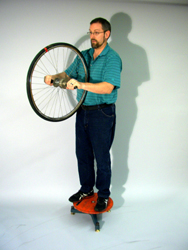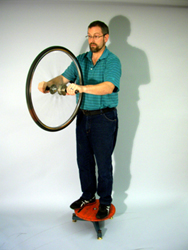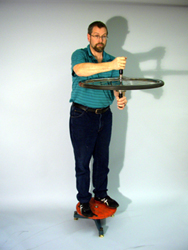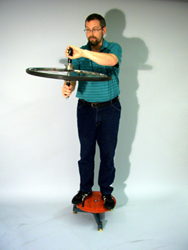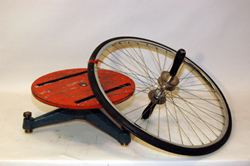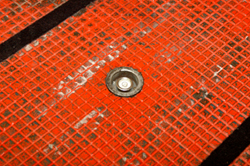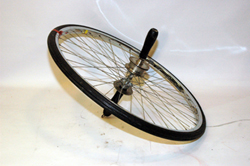Human Gyroscope, 1Q50.15
Topic and Concept:
Rotational Dynamics, 1Q40. Gyroscopic Motion
Location:
Cabinet: Mechanic (ME)
Shelf: #1
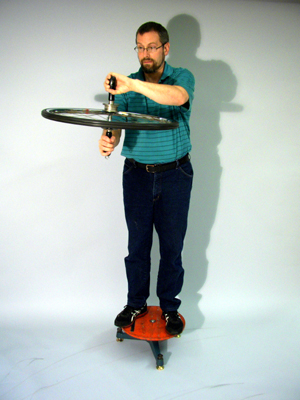
Description:
One stands on a rotating platform and with a spinning bicycle wheel, rotate the bicycle wheel so that it transfer some of it's energy to the rotating platform.
Equipment |
Location |
ID Number |
|
|
|
Rotating Platform |
ME, Bay B9, Shelf #1 |
|
Bicycle Wheel |
|
Important Setup Notes:
- Demonstration may require practice.
- A volunteer may be required.
Setup and Demonstration:
- Set Rotating Platform out on the floor.
- Level the platform.
- Select a volunteer (possibly yourself), and have him or her carefully step onto the platform.
- Get the wheel spinning by grasping a handle (the axle) with one hand. Then, grabbing the outer rim with the other hand, apply a strong, tangential force.
- Hand off the spinning wheel with its plane of rotation vertically oriented to the volunteer (you should still be holding on to the axle) having him or her hold onto the axle with both hands, one on either side. Tell him or her to keep his or her arms straight so as not to bump and thereby slow down the spinning wheel.
- Have the volunteer tilt the wheel so that the plane of rotation approaches horizontal. This will set him or her into rotational motion in a direction opposite that of wheel. The volunteer can control his or her speed by the degree of tilt from vertical. The maximum speed will be reached when the plane is fully horizontal.
- To stop the wheel, warn the volunteer that you are about to do so, and tell him or her to hold the wheel firmly. Then, using a hand or two, slowly grip the tire until the wheel comes to a stop. After the wheel stops, you can take the wheel from the volunteer, and have him or her carefully step off of the platform.
Cautions, Warnings, or Safety Concerns:
- Fingers, long hair, and necklaces may get caught in the spooks of the moving bicycle wheel. Take precautions!
- Due to the high rotational speed of the bicycle wheel, stopping the wheel can be difficult.
- The volunteer may get dizzy from spinning.
Discussion:
When the wheel is spun, it is given some amount of angular momentum whereas the volunteer has none (starting from rest). When the volunteer tilts the wheel, he or she is applying a torque to it and thereby changing its angular momentum. By the conservation of angular momentum (or equivalently Newton's third law), the volunteer feels a torque from the wheel applied in the opposite direction causing him or here to start spinning in a direction opposite that of the wheel. The applied change in angular momentum will be greatest when the torque is applied through an angle of 90°. This is because torque is related to angular acceleration by τ = I*α where I is the moment of inertia of the wheel. α become negative once we pass the 90° mark thereby causing the volunteer to start slowing down. It is this same effect that allows the volunteer to control what direction he or she turns. This is what makes gyroscopes so handy!
|
|
|
|
|
|
|
Videos:
References:
